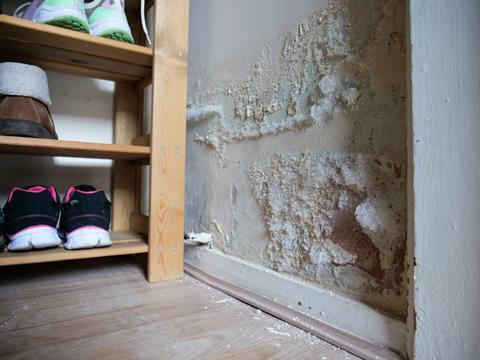Housing providers have seven months to improve inspection processes ahead of the implementation of Awaab’s Law , says watchdog
Social landlords must ensure they have robust records in order to triage cases if they are to deal with damp and mould effectively, the Housing Ombudsman has warned.
The watchdog’s latest report highlights key lessons from instances of severe maladministration by social landlords when dealing with damp and mould.

It said that poor communication and weaknesses in knowledge and information management are shown to “hamper the landlord’s response to residents.”
It said that organisations need “robust records on household circumstances to triage cases and know whether an emergency response is required”, adding that housing providers should “urgently” introduce a triaging system if one is not already in place.
This means that vulnerabilities in a household should be recorded, and appropriate action taken, including accelerating repairs or arranging a temporary move.
The learning from severe maladministration report identifies specific cases and groups them under four common failings across landlord inspections.
These are: failing to do an inspection, or the inspection being limited or incomplete; multiple of conflicting inspections, without the outcomes being reconciled; disconnects between the inspector’s recommendations and the landlord’s proposed works and poorly communicated inspection results, where residents often chase for any information, even if it is vague.
Under the first category, the baby of a Greenwich Council resident was prescribed with an inhaler due to a continuous cough caused by untreated mould.
The local authority failed to undertake an inspection for a year, in which time the family were left sleeping in the living room due to bedrooms in the property being “uninhabitable.”
>>See also: Government announces phased timetable for Awaab’s Law
>>See also: Ombudsman highlights social landlords’ ‘poor communication’ with residents about adaptations
The landlord said its repairs service is “undergoing long term transformation, and it has also provided staff with refresher training and guidance on how to accurately record conditions within a property,” according to the report.
Meanwhile, Together Housing Group was responsible for a poorly communicated inspection case, where it failed to disclose inspection notes to the residents when requested, saying its damp and mould reports are not for tenants, with an “unprofessional email” sent to the complainant showing “poor attitudes towards her.”
There was widespread black mould throughout the property, including the bedframe and mattress that an asthmatic resident was sleeping in.
The landlord did not provide the Ombudsman with the report or evidence from the damp and mould survey, so it is unable to determine whether the inspection was “really carried out or whether it was recorded incorrectly.”
According to the report, Together also “failed to communicate its concerns that the home was too small for the family” and did not “explore the options available” for more appropriate housing.
Related internal communication was branded “poor”, with “language referring blame on the resident and her family for having too many people in the house and failing to heat it properly.”
Together said it has “improved its complaint handling; established a dedicated team to manage damp, mould and condensation cases; and revamped internal systems and processes”, according to the Ombudsman.
The report has been published ahead of the implementation of Awaab’s Law in October 2025, with housing Ombudsman Richard Blakeway emphasising that the “sector has seven months left to mobilise, and we know many landlords are doing so.” Awaab’s Law requires social landlords to deal with health and safety hazards within fixed timescales.
He said: “Central to an effective response is the landlord’s diagnosis of what is causing damp and mould. This can be complex and can require expertise. These cases focus on landlord’s use of inspections, highlighting 4 commons failings we see in our casework. This includes multiple inspections with no progress on repairs or repairs not reflecting the inspector’s recommendations.
“Residents expectations will be raised following a survey in their home. But repeatedly our cases show communication vacuums lasting for months as the resident – and sometimes our investigation – tries to establish what is happening.
“With Awaab’s Law, these silences will need to stop, with communication with residents being open, specific and accurate.
“We hope these cases help landlords to learn from complaints to improve their response to an issue which continues to dominate our casework.”










No comments yet